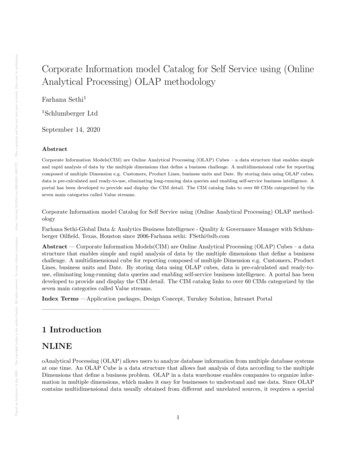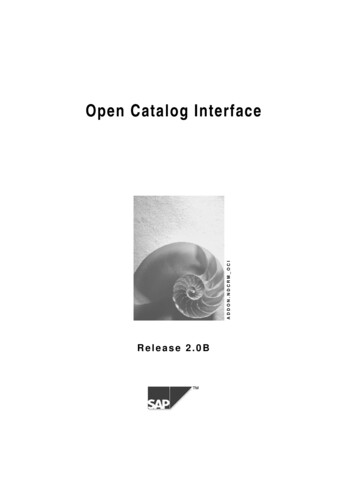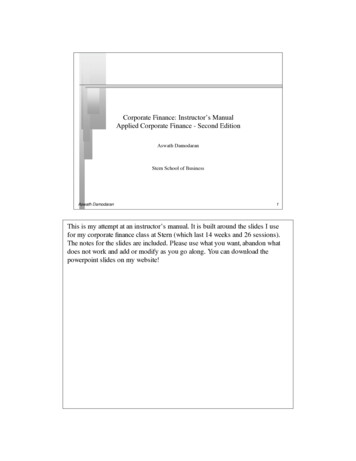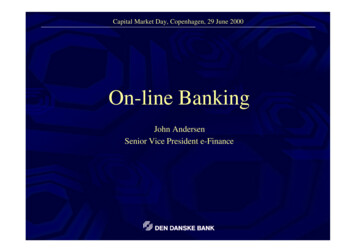
Transcription
Posted on Authorea 14 Sep 2020 — The copyright holder is the author/funder. All rights reserved. No reuse without permission. — https://doi.org/10.22541/au.160010851.13671777 — This a preprint and has not been peer reviewed. Data may be preliminary.Corporate Information model Catalog for Self Service using (OnlineAnalytical Processing) OLAP methodologyFarhana Sethi11Schlumberger LtdSeptember 14, 2020AbstractCorporate Information Models(CIM) are Online Analytical Processing (OLAP) Cubes – a data structure that enables simpleand rapid analysis of data by the multiple dimensions that define a business challenge. A multidimensional cube for reportingcomposed of multiple Dimension e.g. Customers, Product Lines, business units and Date. By storing data using OLAP cubes,data is pre-calculated and ready-to-use, eliminating long-running data queries and enabling self-service business intelligence. Aportal has been developed to provide and display the CIM detail. The CIM catalog links to over 60 CIMs categorized by theseven main categories called Value streams.Corporate Information model Catalog for Self Service using (Online Analytical Processing) OLAP methodologyFarhana Sethi-Global Data & Analytics Business Intelligence - Quality & Governance Manager with Schlumberger Oilfield, Texas, Houston since 2006-Farhana sethi: FSethi@slb.comAbstract — Corporate Information Models(CIM) are Online Analytical Processing (OLAP) Cubes – a datastructure that enables simple and rapid analysis of data by the multiple dimensions that define a businesschallenge. A multidimensional cube for reporting composed of multiple Dimension e.g. Customers, ProductLines, business units and Date. By storing data using OLAP cubes, data is pre-calculated and ready-touse, eliminating long-running data queries and enabling self-service business intelligence. A portal has beendeveloped to provide and display the CIM detail. The CIM catalog links to over 60 CIMs categorized by theseven main categories called Value streams.Index Terms —Application packages, Design Concept, Turnkey Solution, Intranet Portal—————————— ——————————1 IntroductionNLINEoAnalytical Processing (OLAP) allows users to analyze database information from multiple database systemsat one time. An OLAP Cube is a data structure that allows fast analysis of data according to the multipleDimensions that define a business problem. OLAP in a data warehouse enables companies to organize information in multiple dimensions, which makes it easy for businesses to understand and use data. Since OLAPcontains multidimensional data usually obtained from different and unrelated sources, it requires a special1
Posted on Authorea 14 Sep 2020 — The copyright holder is the author/funder. All rights reserved. No reuse without permission. — https://doi.org/10.22541/au.160010851.13671777 — This a preprint and has not been peer reviewed. Data may be preliminary.method of storing that data. OLAP tools enable users to analyze different dimensions of multidimensionaldata using self-service.In our research and implementation scope, we have used OLAP method to provide corporate level multidimensional data to the business users. Corporate Information Models (CIMs) provide trusted and qualifieddata from multiple sources for everyone to build their own business intelligence reports and dashboards.Corporate Information Models are Online Analytical Processing (OLAP) Cubes – a data structure thatenables simple and rapid analysis of data by the multiple dimensions that define a business problem. Amultidimensional cube for reporting composed of multiple Dimension e.g. Customers, Product Lines, businessunits and Date. By storing data using OLAP cubes, data is pre-calculated and ready-to-use, eliminatinglong-running data queries and enabling self-service business intelligence. A portal has been developed toprovide and display the CIM detail. The CIM catalog links to over 60 CIMs categorized by the seven maincategories called Value streams.Application FeatureThere are some key features for the application that make it unique and useful, as mentioned below.CIM CatalogCIM Catalog is a central repository for all the self-service OLAP models in the organization. It containedover 60 models with their description, facts and dimension detail. OLAP models detail synchronize withAzure Analytics Services using Azure Pipelines with daily refresh schedule. Catalog provides insight aboutevery column definition approved by Data Owners, source system detail, connection and access relatedinformation. Every model has a hierarchy and map with main category called value Streams.SocialBusiness users and analytics team members can easily communicate issues or feedback using focused discussions per analytics on CIM catalog such as Feedback, Reviews, and Support and feature requests.Integrated with the ecosystemCIM portal set up as Single-Sign-On with viewer integration. It uses Domain Name System (DNS) andCNAME (Canonical Name record) that is easy to remember and searchable from central internal hub .italso provides authentication on the mobile integrated with Microsoft Intune which is a cloud-based servicethat focuses on mobile device management (MDM) for the organization.Structure the Catalog using TagsTo make all analytics on CIM catalog discoverable, it provides a taxonomy to the catalogs using tags. Thisallows business users to explore what is available in the organization.Drill down to any combinationUsers can easily drill down to the exact combination of what they want to explore. They can also mix andmatch with other filters that are available, such as a filter to only select a particular data source.Supporting ContentAdd supporting content to each CIM model, like: source data, a user guide, utilization metrics or a videowalkthrough. This makes it substantially easier for new users to know their way around the CIM model,especially if it requires more context to understand the analytic assets.Mobile ViewApplication supports mobile view using RWD. Responsive web design (RWD) is a web development approachthat creates dynamic changes to the appearance of a website, depending on the screen size and orientationof the device being used to view it.2
Posted on Authorea 14 Sep 2020 — The copyright holder is the author/funder. All rights reserved. No reuse without permission. — https://doi.org/10.22541/au.160010851.13671777 — This a preprint and has not been peer reviewed. Data may be preliminary.Integrated ViewerIt provides a view of all CIM model right from within Central Catalog. With central catalog users canrequest for access on the OLAP models, read the columns definitions, find the data owners and downloadpre-built Power BI report to explore and customize their own analytics.Application ArchitectureCIM Catalog has been designed and developed in the Microsoft Azure Cloud using SharePoint Online asdescribed in high level architecture diagram Figure 1Microsoft Azure is a cloud computing service created by Microsoft that can be used for deploying andmanaging applications as well as services through a global network of Microsoft-managed data centers.In our research, corporate data source modeling being developed using Microsoft Azure Analysis Serviceswhich is linked with CIM catalog using Microsoft Azure Pipeline.Azure Analysis Services is a fully managed platform as a service (PaaS) that provides enterprise-gradedata models in the Microsoft Azure cloud. Azure Data Factory is Azure’s cloud ETL (Extract, Transform,Load) service for scale-out server-less data integration and data transformation.Figure 1: High-level Architecture diagram – CIM CatalogKey technology and componentsKey technology and components of Digital store are as follows:Web Framework3
Posted on Authorea 14 Sep 2020 — The copyright holder is the author/funder. All rights reserved. No reuse without permission. — https://doi.org/10.22541/au.160010851.13671777 — This a preprint and has not been peer reviewed. Data may be preliminary.In our research we have considered and compare Angular, Angular JS and React for the selection of webframework to develop the application.There are several other web framework available such as Vue, Ember, Meteor, Polymer, Backbone, Aureliaand Mithril. In our research, we have not included the comparison of all other frameworks.Angular: Angular is a web framework and a platform for building mobile and desktop web applicationsusing HTML and Typescript. Angular is written in Typescript (Typescript is an open-source programminglanguage developed and maintained by Microsoft). Angular is used in many public-facing application likeGoogle and YouTube. It is a completely free framework helps to use HTML as a template language, createsRICH Internet Application and offers its developers a client-side application. We have used Version 9 inour application development, Angular 9 was released on February 6, 2020. This latest version moves allapplications to use the Ivy compiler and runtime by default. Ivy is the code name for Agular’s nextgeneration compilation and rendering pipeline. Also it has been updated to work with Typescript 3.6 and3.7.Angular VS. Angular JSIf we compare the performance on Angular with AngularJS then we have better reasons to use Angular.Angular is at least five times faster than AngularJS due to a much better algorithm for data binding anda component-based architecture. The components of an Angular application are quite independent andself-sufficient, which makes them reusable and test friendly.Angular used Typescript and Angular JS uses JavaScript.The main advantage of Typescript over JavaScript is that Typescript is a superset of JavaScript. So Typescript designed for the development of a large program that Trans compile to JavaScript. But Typescriptmay be used to develop a JavaScript application for both client-side and server-side.Angular VS. ReactThere is s detail comparison which has been done between Angular and React as described in Table 1.FeaturesAngularBrief OverviewFull-fledged open-sourced JS Frameworkmanaged by Google and the Angular developer communityLaunched in Sep 2016Both Web and MobileFor mobile development, it needs to be incorporated with Cordova. Moreover, for mobile develoSingle and multiple-page appsAngular is a full-fledged framework for software developmentHence no additional libraries neededAngular itself is a huge library. Angular is more complex to understand, there is a lot of unneceLong and difficultLargeGoogle provides the long-term support of the framework and constantly improves it. However, tAngular is used by such companies as McDonald’s, AT&T, HBO, Apple, Forbes, Adobe, Nike, aCompetitiveOptimized with change detectionJS,TypeScriptFixed and ComplexComponent-based Model, Controller, and viewBuilt-in Material Design toolsetThe greatest advantage of Angular rests in the fact that, unlike React, it supports dependency iIncomprehensible without knowledge of AngularUniversalitySelf-SufficiencyLearning CurveCommunityPerformanceLanguageApp StructureUI ComponentsDirectives4
Posted on Authorea 14 Sep 2020 — The copyright holder is the author/funder. All rights reserved. No reuse without permission. — https://doi.org/10.22541/au.160010851.13671777 — This a preprint and has not been peer reviewed. Data may be preliminary.FeaturesAngularDependency InjectionState ManagementData BindingSupportedEffective improved with NgRx or RxJSBidirectionalData is mutableReal DOM, Change detectionAptana,Sublime Text, Visual studio, Angular CLI, Angular Universal, Jasmine, protector, KarmChange RenderingToolsTable1: Comparison between Angular and React FrameworkTo conclude our comparison, Angular is a full-fledged mobile and web development framework. React isa framework only for UI development, which can be turned into a full-fledged solution with the help ofadditional libraries. In the end, React vs Angular is all a matter of personal preference, a matter of skillsand habits. We have used Angular v9 for the application development.Microsoft SharePoint onlineSharePoint is a cloud-based service offered from Microsoft that helps organizations share and manage content,knowledge, and applications to empower teamwork, quickly find information and seamlessly collaborateacross the organization.In our research and deployment we have privileged enterprise infrastructure setup of SharePoint online incloud to host the application that provides single sign on authentication using O365 with directory services,out of the box workflow development for email send and receive and host the database using SharePointonline Document library and SharePoint lists.Modern AuthenticationModern Authentication is the term Microsoft uses to refer to their implementation of the OAuth 2.0 authorization framework for client/server authentication. By default, modern authentication is enabled forSharePoint online.SharePoint content databaseA content database is a database file that stores content for one or more site collections for SharePoint webapplication. The content can be pages, files, documents, images and much more. In our case, we have usedSharePoint document library, lists and images to save the Catalog information.SharePoint Online WorkflowWorkflows help people to collaborate on documents and to manage project tasks by implementing businessprocesses on documents and items in a SharePoint site. There are five commonly used Workflows thatcan be set up within SharePoint: 1) Approval Workflows,2) Status Workflows,3) Notification Workflows,4)Automation Workflows, and 5) Custom Workflows. In our research and deployment we have set up customworkflow to send emails for Feedback and support form.Visual studio CodeWe have used Visual studio Code for code development. Visual Studio Code is a lightweight but powerfulfree- source code editor made by Microsoft for Windows, Linux and macOS that runs on your desktop. Ithas built-in source code control including Git support. The Visual Studio (VS) Code product itself shipsunder a standard Microsoft product license, as it has a small percentage of Microsoft-specific customizations.It’s free despite the commercial license. We have all the good reasons to use VS Code for our research andtool deployment.Data Structure5
Posted on Authorea 14 Sep 2020 — The copyright holder is the author/funder. All rights reserved. No reuse without permission. — https://doi.org/10.22541/au.160010851.13671777 — This a preprint and has not been peer reviewed. Data may be preliminary.There are 5 main list and 3 document libraries has been used to embrace the catalog information as describedin Figure 2Figure2: SharePoint content databaseEvery SharePoint list has columns to keep the information for the catalog as described in Table 2.List NameCorporate Information ModelColumnCorporate Information Model NameValue StreamServer AddressSource SystemsDescriptionRefresh FrequencyDescriptionCorporate Information Model NameValue Stream (Main Category of the CIM)OLAP Connection AddressSource Systems NameDescriptionRefresh Frequency6
Posted on Authorea 14 Sep 2020 — The copyright holder is the author/funder. All rights reserved. No reuse without permission. — https://doi.org/10.22541/au.160010851.13671777 — This a preprint and has not been peer reviewed. Data may be preliminary.List NameCorporate Information ModelHistory AvailableContactAccessDetails InformationAvailable sinceTagsCSV File PathPBIX File PathStatusList NameTitleList NameTag NameTagColorList NameValue Stream NameValue Stream OwnerValue Stream Data OwnerValue Stream DescriptionValue Stream AcronymList NameAccess NameAccess LinkHelp LinkData retention informationCIM Contact (Data Owner)AccessCIM Details InformationCIM Launch dateTagsCSV File Path for the CIM model data dictionaryPBIX File PathStatus of the CIM Model (Production or under development)Source SystemsEnterprise data source system nameTagsTags name/ Taxonomy to the catalogsDisplay color for the tagsValue StreamsMain category mapping nameCategory OwnerCategory Data OwnerCategory descriptionCategory AcronymAccess TypesAccess application nameAccess application linkTable 2: SharePoint content database Column level detailMapping TechniquesA Smart mapping technique has been used to map OLAP catalog directory with CIM catalo and categoriesas described in Figure 3.7
Posted on Authorea 14 Sep 2020 — The copyright holder is the author/funder. All rights reserved. No reuse without permission. — https://doi.org/10.22541/au.160010851.13671777 — This a preprint and has not been peer reviewed. Data may be preliminary.Figure 3: Column mapping for Data associationFolder StructureThe key guidelines for creating folder structure for an Angular Project is to organize the app such that youcan locate code quickly and have a near-term view of implementation and a long-term vision. We have builtthe structure which focuses on a multiple-module architecture which in turn are divided into pages and ashared set of components with a large focus on scaling as described in Figure 4.8
Posted on Authorea 14 Sep 2020 — The copyright holder is the author/funder. All rights reserved. No reuse without permission. — https://doi.org/10.22541/au.160010851.13671777 — This a preprint and has not been peer reviewed. Data may be preliminary.9
Posted on Authorea 14 Sep 2020 — The copyright holder is the author/funder. All rights reserved. No reuse without permission. — https://doi.org/10.22541/au.160010851.13671777 — This a preprint and has not been peer reviewed. Data may be preliminary.Figure 4: High level Overview of Folder StructureCode architectureWe have adopted the MVCS code architecture for the application development. The Model-View-Controller(MVC) is an architectural pattern that separates an application into three main logical components: themodel, the view, and the controller. MVC is one of the most frequently used industry-standard web development framework to create scalable and extensible projectsModels - To manage the data of an application. The models will be anemic (they will lack functionalities)since they will be referred to the services.Views/Templates - The page/GUI where the user interacts with the app.Controllers - Links between services and views.Services - Manages the SharePoint request data.Angular ComponentsComponents are the most basic building block of an UI in an Angular application. An Angular applicationis a tree of Angular components. Every page has multiple components and one component can belong tomany pages. Below is an example of components breakdown and association with the Storefront landingPage as described in Figure 5.Figure 5: Components Association with the Web pageThere are no more or less important components, all are important, but there are more complex or moreused components.Key ComponentsThere are over 20 components being used to develop the application with all the required features in thescope. Top 3 key components has been identified and mentioned below in Figure 6, 7 and 8.Value Stream Card10
Posted on Authorea 14 Sep 2020 — The copyright holder is the author/funder. All rights reserved. No reuse without permission. — https://doi.org/10.22541/au.160010851.13671777 — This a preprint and has not been peer reviewed. Data may be preliminary.Figure 6: Value Stream CardCorporate Information Card11
Posted on Authorea 14 Sep 2020 — The copyright holder is the author/funder. All rights reserved. No reuse without permission. — https://doi.org/10.22541/au.160010851.13671777 — This a preprint and has not been peer reviewed. Data may be preliminary.Figure 7: Corporate Information CardSearch Bar12
Posted on Authorea 14 Sep 2020 — The copyright holder is the author/funder. All rights reserved. No reuse without permission. — https://doi.org/10.22541/au.160010851.13671777 — This a preprint and has not been peer reviewed. Data may be preliminary.Figure 8: Search BarCodes for the tope 3 key components has been describe in Appendix 1.Inside the ComponentsEvery Component has to be written in three languages.HTML - Hypertext Markup Language (HTML) is the standard markup language for documents designedto be displayed in a web browser.Scss - Scss stands for Sassy Cascading Style Sheets and it’s an extension of CSS which adds nested rulesVariables, mixin, selector, inheritance and a lot more features.TS - TypeScript is an open-source programming language developed and maintained by Microsoft.SharePoint ConnectionSharePoint ship with an updated REST API that can be used to access and control nearly every aspectof a site collection: Lists, Libraries, Permissions, and Users are just some of the objects that have definedendpoints. Integrating Angular, a powerful client-side framework, gives developers and content managersanother option for customizing the user experience. The most important library used in the project is tocreate and manage the connection between the application and the SharePoint structure.Deployment techniqueWe used Minimum Viable Product (MVP) approach for product development strategy. A minimum viableproduct (MVP) is a version of a product with just enough features to satisfy early customers and providefeedback for future product development.Every MVP includes below key elements:Functionality - the set of features deliver clear value to the user.Design - the design of the MVP was up to the highest industry standard.Reliability - production quality standard has been achieved by rigorous testing.Usability - the MVP was easy to use and intuitive.We have used Azure DevOps for code deployment. Azure DevOPS is a Software as a service (SaaS) platformfrom Microsoft that provides an end-to-end DevOps toolchain for developing and deploying software.Azure DevOps being used for code versioning and release pipeline using Git repository with Visual Studiocode tool.Git is a program that tracks changes made to files. Once installed, Git can be initialized on a project tocreate a Git repository. A Git repository is the .git/ folder inside a project. This repository tracks all changesmade to files in the project, building a history over time.A release pipeline is a conceptual process by which we take committed code into production. A releasepipeline takes a build artifact, a result of the build process and deploys that to one or more environments.We have used three environment for the product deployment i.e. Development, Quality Assurance andProduction as described in Figure 9 below.13
Posted on Authorea 14 Sep 2020 — The copyright holder is the author/funder. All rights reserved. No reuse without permission. — https://doi.org/10.22541/au.160010851.13671777 — This a preprint and has not been peer reviewed. Data may be preliminary.Figure 9: Release pipeline in Azure DevOps RepositoryCode Development environment integrates with Azure DevOps Git repository to enable source control management. With source control, developers can collaborate, track and save their changes to a branch andthese changes will be merged into the main branch and deployed to the higher-level environments (Fromdevelopment to Quality Assurance/User Acceptance Test environment to Production), where it will also betested and validated. Once the above mentioned steps are complete the developed codes be published intothe development environment as described in Figure 10Figure 10: Automated deployment using Azure DevOps (Git) RepositoryAzure Release Pipeline Approval/Pre Deployment ConditionsApprovals and gates gives further control over the execution and success of the deployment pipeline. Eachstep in a release pipeline can be built with pre-deployment and post-deployment settings that can embracewaiting for authority users to manually approve or reject deployments, and testing and validating the qualitychecks with any computerized systems until definite requirements are complete. Also, we can constitute amanual interference to pause the deployment pipeline and prompt developers to carry out manual tasks,then resume or reject the deployment.Once the approvals are in place the Release would be promoted to higher environments and finally deployedin Production. Assigned approvers would receive email notification along with the link to approve. Unlessapproved deployment will not take place. Once it is approve and release, pipeline shows with success asdescribed in Figure 1114
Posted on Authorea 14 Sep 2020 — The copyright holder is the author/funder. All rights reserved. No reuse without permission. — https://doi.org/10.22541/au.160010851.13671777 — This a preprint and has not been peer reviewed. Data may be preliminary.Figure11: successful Azure Release PipelineOutputApplication in production has below key displays that will be interesting to show as described in Figure 12,13, 14 for CIM Catalog Landing page , Inside the CIM and Report Selection respectively.Figure 12: CIM Catalog Landing page15
Posted on Authorea 14 Sep 2020 — The copyright holder is the author/funder. All rights reserved. No reuse without permission. — https://doi.org/10.22541/au.160010851.13671777 — This a preprint and has not been peer reviewed. Data may be preliminary.Figure 13: Inside the CIMFigure 14: Report SelectionUtilization trackingUtilization tracking for the Web application is one of the key strategy to get the adoption over the periodof time. If you’re not tracking enough data, you won’t see how trends change over time or why some usersbehave one way versus another. You won’t understand user engagement. Ultimately, you just won’t havethe knowledge to make smart product or marketing decisions. We have enabled and configured Utilizationof the CIM Catalog application due to the precise reasons as follows.*To find out which storefront bring the most traffic and conversions.*Determine where the best visitors are located in the worldwide.*Learn what people are searching for on the application.*Visualize what people click on the most.*Uncover the top content. Which pages keep the visitors on the site the longest.16
Posted on Authorea 14 Sep 2020 — The copyright holder is the author/funder. All rights reserved. No reuse without permission. — https://doi.org/10.22541/au.160010851.13671777 — This a preprint and has not been peer reviewed. Data may be preliminary.*To identify the worst performing pages.*Determine where people abandon due to having multiple clicksWe have used and compared SharePoint activity tracker and Google analytics to enable application tracking.Microsoft SharePoint AnalyticsWe get a view into SharePoint activity using Microsoft SharePoint Analytics by looking at the Files andUsers views. It is out of the box services available within Microsoft SharePoint Online in Cloud.This can simply be enabled by the Site admin from the admin center, Go to the Reports Usage page.From the Select a report drop-down, select SharePoint Activity.The Pages view shows the number of unique pages visited by users as mentioned in the figure 15.Figure 15: Utilization analysis from SharePoint OnlineGoogle Analytics1 “Site owners using Google Analytics have the capacity to keep track of views over time, follow site visitors’move-ments in real time, pinpoint where site visitors leave, view demographics and maps, and understandthe search terms that initially brought visitors to the website”1.Google Analytics provide detail analysis and is used to track website activity such as session duration, pagesper session, bounce rate etc. of individuals using the site, along with the information on the source of thetraffic. In order for Google Analytics to function, we were required to put JavaScript tracking code on eachpage of our application. When a visitor comes to the application, the tracking code runs and sends trackingdata to Google’s data collection servers. Hence, we have enabled monitoring for usage analysis over theperiod of time by adding below line of tracking code in the html as described in Table 3. !– Global site tag (gtag.js) - Google Analytics – script async src ”https://www.googletagmanager.com/gtag/js?id UATable 3: Tracking code for Google AnalyticIn our analysis we decided to use Google analytics as it provides detail and comprehensive active user’s trendover the period of time as described in Figure 16 and Figure 17 below.17
Posted on Authorea 14 Sep 2020 — The copyright holder is the author/funder. All rights reserved. No reuse without permission. — https://doi.org/10.22541/au.160010851.13671777 — This a preprint and has not been peer reviewed. Data may be preliminary.Figure 16: Active user’s trend in Google AnalyticsFigure 17: Overall traffic analysis from Google analytics18
Posted on Authorea 14 Sep 2020 — The copyright holder is the author/funder. All rights reserved. No reuse without permission. — https://doi.org/10.22541/au.160010851.13671777 — This a preprint and has not been peer reviewed. Data may be preliminary.Security OverviewCIM Catalog is hosted in Microsoft SharePoint Online environment in Cloud, hence it is inherited the securityframework what SharePoint offered. SharePoint has the default security groups which are the SharePointobjects that have “users” (Azure Active Directory Users and Azure Active Directory Groups by default) asmembers and come with their own settings.There are 5 main layers of Security available in the CIM Catalog environment:Read: Can view pages and list items and download documents.Contribute: Can view, add, update, and delete list items and documents.Edit: Can add, edit and delete lists; can view, add, update and delete list items and documents.Restricted Edit: Can add, edit and delete specific rows from the list based on the defined role.Design: Can view, add, update, delete, approve, and customize.Full Control: Has full control.There are three security groups. Members, Owners and Visitors.Users required to be added into a security group. Each security group has unique Permission level asdescri
Angular used Typescript and Angular JS uses JavaScript. The main advantage of Typescript over JavaScript is that Typescript is a superset of JavaScript. So Type-script designed for the development of a large program that Trans compile to JavaScript. But Typescript may be used to develop a JavaScript application for both client-side and server-side.











